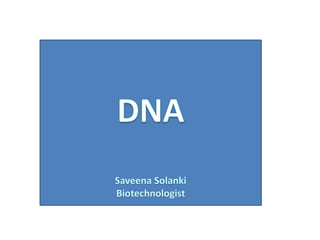
7 DNA
- 2. Experimental demonstration that DNA is the genetic material. These experiments, carried out in the 1940s, showed that adding purified DNA to a bacterium changed its properties and that this change was faithfully passed on to subsequent generations. Two closely related strains of the bacterium Streptococcus pneumoniae differ from each other in both their appearance under the microscope and their pathogenicity. One strain appears smooth (S) and causes death when injected into mice, and the other appears rough (R) and is nonlethal. (A) This experiment shows that a substance present in the S strain can change (ortransform) the R strain into the S strain and that this change is inherited by subsequent generations of bacteria. (B) This experiment, in which the R strain has been incubated with various classes of biological molecules obtained from the S strain, identifies the substance as DNA.
- 4. • Each DNA Molecule That Forms a Linear Chromosome • Contain a Centromere, Two Telomeres, and • Replication Origins • basic functions are controlled by three types of specialized nucleotide sequence in the DNA, • Each of which binds specific proteins that guide the machinery that replicates and segregates chromosomes
- 5. • centromere, allows one copy of each duplicated and condensed chromosome to be pulled into each daughter cell when a cell divides. • A protein complex called a kinetochore forms at the centromere and attaches the duplicated chromosomes to the mitotic spindle, – allowing them to be pulled apart
- 6. • The third specialized DNA sequence forms telomeres, the ends of a chromosome. • Telomeres contain repeated nucleotide sequences that enable the ends of chromosomes to be efficiently replicated. • Telomeres also perform another function: – the repeated telomere DNA sequences, together with the regions adjoining them, – form structures that protect the end of the chromosome – from being recognized by the cell as a broken DNA molecule in need of repair.
- 7. The three DNA sequences required to produce a eucaryotic chromosome that can be replicated and then segregated at mitosis. Each chromosome has multiple origins of replication, one centromere, and two telomeres. Shown here is the sequence of events a typical chromosome follows during the cell cycle. The DNA replicates in interphase beginning at the origins of replication and proceeding bidirectionally from the origins across the chromosome. In M phase, the centromere attaches the duplicated chromosomes to the mitotic spindle so that one copy is distributed to each daughter cell during mitosis. The centromere also helps to hold the duplicated chromosomes together until they are ready to be moved apart. The telomeres form special caps at each chromosome end.
- 8. • Nucleosomes Are the Basic Unit of Eucaryotic Chromosome Structure • The proteins that bind to the DNA to form eucaryotic chromosomes are traditionally divided into two general classes: – the histones and the nonhistone chromosomal proteins. • The complex of both classes of protein with the nuclear DNA of eucaryotic cells is known as chromatin.
- 9. • Histones are responsible for the first and most basic level of chromosome organization, the nucleosome, which was discovered in 1974. • When interphase nuclei are broken open very gently and their contents examined under the electron microscope, most of the chromatin is in the form of a fiber with a diameter of about 30 nm. • If this chromatin is subjected to treatments that cause it to unfold partially, it can be seen under the electron microscope as a series of "beads on a string”. • The string is DNA, and each bead is a "nucleosome core particle" that consists of DNA wound around a protein core formed from histones. • The beads on a string represent the first level of chromosomal DNA packing.
- 10. Nucleosomes as seen in the electron microscope. (A) Chromatin isolated directly from an interphase nucleus appears in the electron microscope as a thread 30 nm thick. (B) (B) This electron micrograph shows a length of chromatin that has been experimentally unpacked, or decondensed, after isolation to show the nucleosomes
- 11. • The structural organization of nucleosomes was determined after first isolating them from unfolded chromatin by digestion with particular enzymes (called nucleases) that break down DNA by cutting between the nucleosomes. • After digestion for a short period, the exposed DNA between the nucleosome core particles, the linker DNA, is degraded. • Each individual nucleosome core particle consists of a – complex of eight histone proteins two molecules each of histones H2A, H2B, H3, and H4 – and double-stranded DNA that is 146 nucleotide pairs long. • The histone octamer forms a protein core around which the double-stranded DNA is wound
- 12. Structural organization of the nucleosome. A nucleosome contains a protein core made of eight histone molecules. As indicated, the nucleosome core particle is released from chromatin by digestion of the linker DNA with a nuclease, an enzyme that breaks down DNA. (The nuclease can degrade the exposed linker DNA but cannot attack the DNA wound tightly around the nucleosome core.) After dissociation of the isolated nucleosome into its protein core and DNA, the length of the DNA that was wound around the core can be determined. This length of 146 nucleotide pairs is sufficient to wrap 1.65 times around the histone core.
- 13. The structure of a nucleosome core particle, as determined by x-ray diffraction analyses of crystals. Each histone is colored, with the DNA double helix in light gray